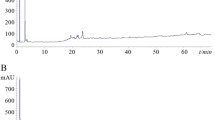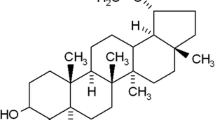Abstract
Rutin is one of the flavonoids found in fruits and vegetables. The PI3K/AKT/mTOR signaling pathway is critical for the life cycle at the cellular level. In current study, we purposed to demonstrate the antitumoral effect of rutin at different doses through the mTOR-signaling pathway and argyrophilic nucleolar regulatory region. EAC cells were injected subcutaneously into the experimental groups. 25 and 50 mg/kg Rutin were injected intraperitoneally to the animals with solid tumors for 14 days. Immunohistochemical, Real-time PCR and AgNOR analyzes were actualized on the taken tumors. When the rutin given groups and the tumor group were compared, the tumor size increase was detected to be statistically significant (p < 0.05). In immunohistochemical analysis, a significant decrease was encountered in the AKT, mTOR, PI3K and F8 expressions especially in the groups administered 25 mg Rutin, in comparison with the control group (p < 0.05). AgNOR area/nuclear area (TAA/NA) and average AgNOR number were determineted, and statistically important differences were detected between the groups in terms of TAA/NA ratio (p < 0.05). There were significant statistical differences between the mRNA quantity of the PI3K, AKT1 and mTOR genes (p < 0.05). In the in vitro study, cell apoptosis was evaluated with different doses of annexin V and it was determined that a dose of 10 µg/mL Rutin induced apoptosis (p < 0.05). In our study, it was demonstrated in vivo and in vitro that Rutin has an anti-tumor effect on the development of solid tumors formed by both EAC cells.








Similar content being viewed by others
Data Availability
The datasets generated during and/or analysed during the current study are available from the corresponding author on reasonable request.
References
Saleh A, ElFayoumi HM, Youns M, Barakat W. Rutin and orlistat produce antitumor effects via antioxidant and apoptotic actions. Naunyn Schmiedebergs Arch Pharmacol. 2019. https://doi.org/10.1007/s00210-018-1579-0.
Chabner BA, Roberts TG Jr. Timeline: chemotherapy and the war on cancer. Nat Rev Cancer. 2005. https://doi.org/10.1038/nrc1529.
Diaby V, Tawk R, Sanogo V, Xiao H, Montero AJ. A review of systematic reviews of the cost-effectiveness of hormone therapy, chemotherapy, and targeted therapy for breast cancer. Breast Cancer Res Treat. 2015. https://doi.org/10.1007/s10549-015-3383-6.
Albalawi AE, Althobaiti NA, Alrdahe SS, Alhasani RH, Alaryani FS, BinMowyna MN. Anti-tumor effects of queen bee acid (10-hydroxy-2-decenoic acid) alone and in combination with cyclophosphamide and its cellular mechanisms against Ehrlich solid tumor in mice. Molecules. 2021. https://doi.org/10.3390/molecules26227021.
Sayed HM, Said MM, Morcos NYS, El Gawish MA, Ismail AFM. Antitumor and radiosensitizing effects of zinc oxide-caffeic acid nanoparticles against solid Ehrlich Carcinoma in female mice. Integr Cancer Ther. 2021. https://doi.org/10.1177/15347354211021920.
Nafees S, Mehdi SH, Zafaryab M, Zeya B, Sarwar T, Rizvi MA. Synergistic interaction of rutin and silibinin on human colon cancer cell line. Arch Med Res. 2018. https://doi.org/10.1016/j.arcmed.2018.09.008.
Khan MM, Ahmad A, Ishrat T, Khuwaja G, Srivastawa P, Khan MB, Raza SS, Javed H, Vaibhav K, Khan A, Islam F. Rutin protects the neural damage induced by transient focal ischemia in rats. Brain Res. 2009. https://doi.org/10.1016/j.brainres.2009.07.026.
Stewart LK, Soileau JL, Ribnicky D, Wang ZQ, Raskin I, Poulev A, Majewski M, Cefalu WT, Gettys TW. Quercetin transiently increases energy expenditure but persistently decreases circulating markers of inflammation in C57BL/6J mice fed a high-fat diet. Metabolism. 2008. https://doi.org/10.1016/j.metabol.2008.03.003.
Magalingam KB, Radhakrishnan A, Haleagrahara N. Rutin, a bioflavonoid antioxidant protects rat pheochromocytoma (PC-12) cells against 6-hydroxydopamine (6-OHDA)-induced neurotoxicity. Int J Mol Med. 2013. https://doi.org/10.3892/ijmm.2013.1375.
Yılmaz S, Aslan E, Doğanyiğit Z. Detection of antitumoral effects of quercetin through protein synthesis associated with argyrophilic nucleolar-regulating region. Hum Exp Toxicol. 2021. https://doi.org/10.1177/0960327120943916.
Pandey P, Khan F, Qari HA, Oves M. Rutin (Bioflavonoid) as cell signaling pathway modulator: prospects in treatment and chemoprevention. Pharmaceuticals (Basel). 2021. https://doi.org/10.3390/ph14111069.
Fattahi S, Amjadi-Moheb F, Tabaripour R, Ashrafi GH, Akhavan-Niaki H. PI3K/AKT/mTOR signaling in gastric cancer: Epigenetics and beyond. Life Sci. 2020. https://doi.org/10.1016/j.lfs.2020.118513.
Talebi H, Farahpour MR, Hamishehkar H. The effectiveness of Rutin for prevention of surgical induced endometriosis development in a rat model. Sci Rep. 2021. https://doi.org/10.1038/s41598-021-86586-4.
Thabet NM, Moustafa EM. Protective effect of rutin against brain injury induced by acrylamide or gamma radiation: role of PI3K/AKT/GSK-3β/NRF-2 signalling pathway. Arch Physiol Biochem. 2018. https://doi.org/10.1080/13813455.2017.1374978.
Ozbey U, Attar R, Romero MA, Alhewairini SS, Afshar B, Sabitaliyevich UY, Hanna-Wakim L, Ozcelik B, Farooqi AA. Apigenin as an effective anticancer natural product: Spotlight on TRAIL, WNT/β-catenin, JAK-STAT pathways, and microRNAs. J Cell Biochem. 2019. https://doi.org/10.1002/jcb.27575.
Ceylan D, Aksoy A, Ertekin T, Yay AH, Nisari M, Karatoprak GŞ, Ülger H. The effects of gilaburu (Viburnum opulus) juice on experimentally induced Ehrlich ascites tumor in mice. J Cancer Res Ther. 2018. https://doi.org/10.4103/0973-1482.181173.
Nisari M, Yilmaz S, Eroz R, Ertekin T, Bircan D, Ulger H. The detection of curcumins’ antitumoral effects via argyrophilic nucleolar organizing region-associated protein synthesis in mice with ehrlich’s ascitic carcinoma. Bratisl Lek Listy. 2017. https://doi.org/10.4149/bll_2017_012.
Ertekin T, Bozkurt O, Eroz R, Nisari M, Bircan D, Nisari M, Unur E. May argyrophilic nucleolar organizing region-associated protein synthesis be used for selecting the most reliable dose of drugs such as rhamnetin in cancer treatments? Bratisl Lek Listy. 2016. https://doi.org/10.4149/bll_2016_126.
Kandiş H, Afacan MA, Eröz R, Colakoglu S, Bayramoglu A, Oktay M, Saritas A, Colak S, Kaya M, Kara İH. Can argyrophilic nucleolar organizing region-associated protein amount be used for the detection of cardiac damage? Hum Exp Toxicol. 2016. https://doi.org/10.1177/0960327115579432.
O’Reilly MS, Boehm T, Shing Y, Fukai N, Vasios G, Lane WS, Flynn E, Birkhead JR, Olsen BR, Folkman J. Endostatin: an endogenous inhibitor of angiogenesis and tumor growth. Cell. 1997. https://doi.org/10.1016/s0092-8674(00)81848-6.
Doğanyiğit Z, Okan A, Kaymak E, Pandır D, Silici S. Investigation of protective effects of apilarnil against lipopolysaccharide induced liver injury in rats via TLR 4/ HMGB-1/ NF-κB pathway. Biomed Pharmacother. 2020. https://doi.org/10.1016/j.biopha.2020.109967.
Ploton D, Menager M, Jeannesson P, Himber G, Pigeon F, Adnet JJ. Improvement in the staining and in the visualization of the argyrophilic proteins of the nucleolar organizer region at the optical level. Histochem J. 1986. https://doi.org/10.1007/bf01676192.
Ateş Ş, Ülger H, Yilmaz S, Karatoprak GŞ, Al Ö, Uçar S, Taştan M, Tokpinar A, Alpa Ş, Farooqi AA. Evaluation of antitumoral effect of mistletoe fruit extract on Ehrlich ascites tumor cells with muse cell analyzer and argyrophilic nucleolar organizer region staining method. Postępy Hig Med Dośw. 2022. https://doi.org/10.2478/ahem-2022-0014.
Pfaffl MW, Horgan GW, Dempfle L. Relative expression software tool (REST) for group-wise comparison and statistical analysis of relative expression results in real-time PCR. Nucleic Acids Res. 2002. https://doi.org/10.1093/nar/30.9.e36.
Chakraborty S, Njah K, Pobbati AV, Lim YB, Raju A, Lakshmanan M, Tergaonkar V, Lim CT, Hong W. Agrin as a mechanotransduction signal regulating YAP through the hippo pathway. Cell Rep. 2017. https://doi.org/10.1016/j.celrep.2017.02.041.
Negahdari R, Bohlouli S, Sharifi S, Maleki Dizaj S, Rahbar Saadat Y, Khezri K, Jafari S, Ahmadian E, Gorbani Jahandizi N, Raeesi S. Therapeutic benefits of rutin and its nanoformulations. Phytother Res. 2021. https://doi.org/10.1002/ptr.6904.
Fei J, Sun Y, Duan Y, Xia J, Yu S, Ouyang P, Wang T, Zhang G. Low concentration of rutin treatment might alleviate the cardiotoxicity effect of pirarubicin on cardiomyocytes via activation of PI3K/AKT/mTOR signaling pathway. 2019. Biosci Rep. https://doi.org/10.1042/bsr20190546.
Huang S. mTOR signaling in metabolism and cancer. Cells. 2020. https://doi.org/10.3390/cells9102278.
Zhao B, Xiong Y, Zhang Y, Jia L, Zhang W, Xu X. Rutin promotes osteogenic differentiation of periodontal ligament stem cells through the GPR30-mediated PI3K/AKT/mTOR signaling pathway. Exp Biol Med (Maywood). 2020. https://doi.org/10.1177/1535370220903463.
Wen W, Marcinkowski E, Luyimbazi D, Luu T, Xing Q, Yan J, Wang Y, Wu J, Guo Y, Tully D, Han ES, Yost SE, Yuan Y, Yim JH. Eribulin synergistically increases anti-tumor activity of an mTOR inhibitor by inhibiting pAKT/pS6K/pS6 in triple negative breast cancer. Cells. 2019. https://doi.org/10.3390/cells8091010.
Vladić J, Ćebović T, Vidović S, Jokić S. Evaluation of anticancer activity of Satureja montana supercritical and spray-dried extracts on Ehrlich’s Ascites Carcinoma bearing mice. Plants (Basel). 2020. https://doi.org/10.3390/plants9111532.
Ahmed OM, Elkomy MH, Fahim HI, Ashour MB, Naguib IA, Alghamdi BS, Mahmoud HUR, Ahmed NA. Rutin and quercetin counter doxorubicin-induced liver toxicity in wistar rats via their modulatory effects on inflammation, oxidative stress, apoptosis, and Nrf2. Oxid Med Cell Longev. 2022. https://doi.org/10.1155/2022/2710607.
Pandey P, Khan F, Alzahrani FA, Qari HA, Oves M. A novel approach to unraveling the apoptotic potential of Rutin (Bioflavonoid) via targeting Jab1 in cervical cancer cells. Molecules. 2021. https://doi.org/10.3390/molecules26185529.
Lelas A, Greinix HT, Wolff D, Eissner G, Pavletic SZ, Pulanic D. Von Willebrand factor, factor VIII, and other acute phase reactants as biomarkers of inflammation and endothelial dysfunction in chronic graft-versus-host disease. Front Immunol. 2021. https://doi.org/10.3389/fimmu.2021.676756.
Lacroix-Desmazes S, Voorberg J, Lillicrap D, Scott DW, Pratt KP. Tolerating factor VIII: Recent progress. Front Immunol. 2020. https://doi.org/10.3389/fimmu.2019.02991.
Nisari M, Eröz R. Does capsaicin have therapeutic benefits in human colon adenocarcinoma? Selection of the most reliable dose via AgNOR. Turk J Med Sci. 2020. https://doi.org/10.3906/sag-2003-251.
Eroz R, Tasdemir S, Dogan H. Is there any relationship between decreased AgNOR protein synthesis and human hair loss? Biotech Histochem. 2012. https://doi.org/10.3109/10520295.2012.698307.
Firouzai-Amandi A, Tarahomi M, Rahmani Youshanlouie H, Mosaddeghi Heris R, Jafari-Gharabaghlou D, Zarghami N, Dadashpour M. Development, characterization, and in vitro evaluation of cytotoxic activity of Rutin loaded PCL-PEG nanoparticles against Skov3 ovarian cancer cell. Asian Pac J Cancer Prev. 2022. https://doi.org/10.31557/apjcp.2022.23.6.1951.
Pandey P, Khan F, Farhan M, Jafri A. Elucidation of rutin’s role in inducing caspase-dependent apoptosis via HPV-E6 and E7 down-regulation in cervical cancer HeLa cells. 2021. Biosci Rep. https://doi.org/10.1042/bsr20210670.
Khan F, Pandey P, Jha NK, Khalid M, Ojha S. Rutin mediated apoptotic cell death in Caski cervical cancer cells via Notch-1 and Hes-1 downregulation. Life (Basel). 2021. https://doi.org/10.3390/life11080761.
Acknowledgments
Thanks to Yozgat Bozok University Scientific Research Projects Coordination Unit for financial support for the project.
Funding
This project was financially supported by Yozgat Bozok University Scientific Research Projects Coordination Unit (Grant Number: 6602c-TF/21-480).
Author information
Authors and Affiliations
Contributions
Material preparation, conceptualization and project administration were performed by [SY] and [ZD]. Data collection and analysis, validation were performed by [AOO], [ŞA] and [ESAS]. Writing—Review & Editing were performed by [MN] and [AAF]. All authors read and approved the final manuscript.
Corresponding author
Ethics declarations
Conflict of interest
None.
Ethics Approval
The stage of the study on experimental animals was carried out in accordance with the decision numbered 20/105 taken from the Animal Experiments Local Ethics Committee of Erciyes University (Decision date: 12.08.2020).
Additional information
Publisher's Note
Springer Nature remains neutral with regard to jurisdictional claims in published maps and institutional affiliations.
Rights and permissions
Springer Nature or its licensor (e.g. a society or other partner) holds exclusive rights to this article under a publishing agreement with the author(s) or other rightsholder(s); author self-archiving of the accepted manuscript version of this article is solely governed by the terms of such publishing agreement and applicable law.
About this article
Cite this article
Yılmaz, S., Doğanyiğit, Z., Oflamaz, A.O. et al. Determination of Rutin's antitumoral effect on EAC solid tumor by AgNOR count and PI3K/AKT/mTOR signaling pathway. Med Oncol 40, 131 (2023). https://doi.org/10.1007/s12032-023-01999-7
Received:
Accepted:
Published:
DOI: https://doi.org/10.1007/s12032-023-01999-7




